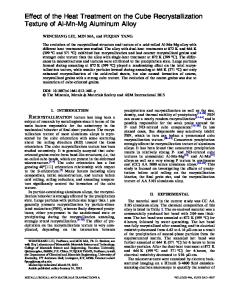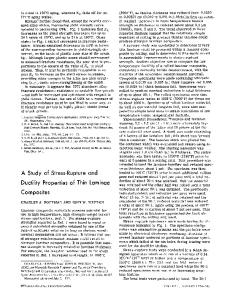Effect of Heat Treatment on Commercial AlSi12Cu1(Fe) and AlSi12(b) Aluminum Alloy Die Castings
- PDF / 2,710,437 Bytes
- 10 Pages / 593.972 x 792 pts Page_size
- 82 Downloads / 314 Views
I.
INTRODUCTION
WORLDWIDE, aluminum foundries are benefitting from the trend toward lightweight construction, since aluminum combines low density with reasonable strength. By 2020, global aluminum foundry production is expected to reach 17 million tons.[1] It is therefore essential for the industry to use economically suitable processes that can provide high production rates and lightweight products with close dimensional tolerances and smooth surface finishes. More than 60 pct of the global production of aluminum alloys castings use high-pressure die casting (HPDC), as it is a manufacturing process that adequately fulfills all the previously listed requirements. Specifically, its advantages include a higher production rate than is achievable with gravity or low-pressure die casting processes, as well as the ability to produce castings with close dimensional tolerances, which reduces the subsequent machining operations required.[2,3] However, several operations and processes are involved in implementing the HPDC procedure from the starting liquid metal to the finished shape[4]. Due to the complexity of this process, HPDC castings generally contain undesired features such as entrapped gas- or
E. BATTAGLIA, F. BONOLLO, P. FERRO, and A. FABRIZI are with the Department of Management and Engineering, University of Padova, Stradella S. Nicola, 3, 36100 Vicenza, Italy. Contact e-mail: [email protected] Manuscript submitted May 2, 2017.
METALLURGICAL AND MATERIALS TRANSACTIONS A
shrinkage-porosity, oxide skins, cold shuts, hard primary intermetallic particles, and others[5–9]. In HPDC, the molten metal experiences an extreme turbulent flow as it is forced into the die at high speed, and a very rapid solidification rate is reached. The inevitable internal porosity that results is one of the prevalent defects in HPDC that makes producing pressure-tight parts difficult. Moreover, the presence of gaseous phases under high pressure (Figure 1) prevents conventionally produced HPDC components from undergoing subsequent heat treatment at high temperatures without causing flaws, particularly blisters[10]. These issues confirm that the variables affecting the microstructure and generation of defects include not only alloy composition and production processes but also heat treatment. Recently, it was established that conventional HPDC castings can be heat-treated without causing unacceptable surface blisters or compromising their mechanical properties. Lumley et al. demonstrated that lower solution-treatment temperatures and shorter times than those normally used for Al-Si-based alloys should effectively produce a good age-hardening response without surface blistering. The same studies showed that attaining desirable mechanical properties is possible even when the solution-treatment temperature is reduced to as low as 714 K (440 °C) and the time held at this temperature is less than 15 minutes of the total heat treatment[7,11,12]. It is well established that Si particles undergo significant changes in size and shape during solution treat
Data Loading...











